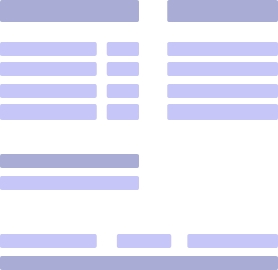What is a Progressive Tax? Definition and Examples [2025]

May 02, 2023
Taxes are essential for advancing an economy because they generate funds for government programs and infrastructure. The rules and regulations governing taxpayers’ contributions are determined by the federal and state authorities.
There are different tax systems that govern how taxes are deducted from your regular income. A progressive tax is an example of one of these tax systems. It’s a tax that increases as the taxpayer reaches a higher pay grade.
This article will tell you all about progressive tax, explain how it is imposed, and explain how it differs from other types of tax systems.
Let’s jump straight to it!
Key Takeaways
- A progressive tax is a tax system that levies higher taxes on high-income individuals and lower tax rates on low-income households.
- Some benefits of progressive tax include relieving the tax burden from the poor, promoting economic equality, and generating more funds for government programs.
- A progressive tax discourages taxpayers from making more money, entails higher administrative costs, and indirectly encourages capital flight in high-income households.
- A regressive tax applies a flat tax rate on all goods and services, which means high, middle, and low-income households pay the same tax amounts.
What is a Progressive Tax?
A progressive tax is a tax system wherein the tax burden is raised as the taxpayer’s income increases. What this means is that lower tax rates are imposed on low-income households while higher tax rates are levied on higher-income individuals.
Tax brackets go hand in hand with progressive taxation. The brackets help categorize and group taxpayers based on their income range. Currently, there are sevenfederal income tax brackets in the US: 10%, 12%, 22%, 24%, 32%, 35%, and 37%.
A progressive tax system effectively restores the spending power of low-income individuals. Compared to regressive taxation, which imposes a flat tax rate for both low and high-income individuals, progressive taxes reduce the amount deducted from people who make less than what is considered a livable wage.
Why is Progressive Tax Important?
What makes progressive tax important is that it spreads out tax responsibilities. The poor can contribute to the economy without worrying about losing disposable income to spend on their needs.
With taxpayers from low, middle, and high-income households able to pay their fair share of taxes, regular funding for government programs and services is more secure.
Advantages of a Progressive Tax
The following are the advantages that a progressive tax can bring to taxpayers, the government, and the economy:
- Relieves tax burden from the poor. Tax thresholds determine the amount of tax deducted based on how much a taxpayer earns annually. Consequently, financially disadvantaged households pay lower taxes and keep more of what they earn.
- Increases support for social welfare programs. A progressive tax helps the government generate more revenue to fund social security services, housing assistance, programs and benefits for the disabled, unemployment benefits, and income support for low-income families.
- Pushes economic equality. Households earning a smaller income are left with more of their earnings to spend on their basic needs. Meanwhile, unnecessary expenditure by the rich is significantly curbed to help shift the focus to addressing the lack of funding for public services.
Disadvantages of a Progressive Tax
As with all other tax systems, progressive taxation also comes with its own set of disadvantages:
- Economic net drain. Progressive taxation discourages individuals from pursuing potential business opportunities. With fewer new businesses opening, there is also reduced competition in the market, and the economy inevitably declines.
- Capital flight. When the rich get taxed a higher amount, they are likely to find ways to evade taxation. Capital flight is an example. It involves moving one’s capital to invest it in other countries where the tax rates are remarkably lower.
- High administrative costs. A progressively increasing tax system paves the way for creating more tax brackets with increments that go as high as 70-80%. The more tax brackets there are, the more expensive and challenging it will be for the Internal Revenue Service (IRS) to manage and implement them.
Differences Between Progressive Tax and Regressive Tax

If a progressive tax deducts higher tax rates from high-earning households, a regressive tax is the opposite. Regressive taxation imposes a uniform tax rate on all taxpayers, regardless of whether they are low, middle, or high-income earners.
VAT (value-added tax) is often regarded as a type of regressive tax, especially when calculated based on income level. But when measured in relation to expenses, VAT’s allocative influence on costs makes it somewhat progressive.
Another key difference between progressive and regressive taxes is the basis for levying tax rates.
The progressive tax rate takes the taxpayer’s income into consideration, while the regressive tax evaluates the value of properties and assets owned, sold, or purchased by taxpayers in imposing taxes.
In that sense, if a low-income, middle-income, and high-income earner all purchase goods with the same amount and the same tax rate, it is the low-income individual who ends up spending the most money.
How Does a Flat Tax Compare to a Progressive Tax?
A flat tax levies a single tax rate on all taxpayers, meaning that high or low-earning individuals do not pay more or less taxes than others. Although a flat tax also aims for fairness in taxation, it discounts the fact that goods with a higher price range combined with a flat tax percentage create a bigger financial burden for the poor to carry.
As such, the poor may be left with hardly anything to spend on their basic needs, while the tax burden is not felt as much by high-income taxpayers.
On a positive note, flat tax rates encourage individuals to generate higher income since they do not have to worry about shouldering bigger tax consequences.
Progressive Tax Examples
Here are some progressive tax examples implemented by the government:
- Accrued interest. It pertains to savings and investments that generate interest or passive income.
- Estate tax. It is imposed when a deceased taxpayer has assets or properties with a corresponding value that exceeds what the government has set as the threshold amount.
- Investment income tax. Activities such as sales or trade that generate revenue are taxed to regulate the earnings, investments, and savings incurred by high-income individuals.
- Rental income. Rental payments and expenses made by tenants are considered rental income.
How Does Inflation Affect Progressive Taxation?
One of the strongest impacts of economic inflation on progressive taxation is that taxpayers are moved to higher tax brackets. When the prices of goods and commodities go up, it demands higher contributions from taxpayers.
It will be even more difficult for low-income workers to keep up with the inflated prices and higher tax rates, leaving them with close to nothing left of their hard-earned money.
Progressive Tax FAQ
#1. What is the definition of a progressive tax system?
Tax rates that increase as taxable income increases are the simplest way to explain the progressive tax definition. A progressive tax uses tax brackets that categorize taxpayers based on their filing status and income range.
#2. What is the difference between regressive and degressive tax?
A regressive tax imposes a flat tax rate on all goods and services. On the other hand, a degressive tax involves tax rates that decrease as the taxable amount on goods or prices increases.
#3. Why is it called progressive tax?
It is called a progressive tax simply because the tax burden or tax percentage increases as the taxpayer’s income increases.
#4. Which type of tax is most regressive?
Sales and excise taxes are said to be the most regressive in terms of levying a flat rate on services and goods. Sales taxes tend to leave a heavier tax burden on the poor, while excise taxes are levied on tobacco, fuel, and alcohol and are meant to curb the purchase of such commodities.
Final Thoughts
Progressive tax comes with benefits and disadvantages that may or may not be ideal for all taxpayers. Familiarizing yourself with how progressive taxation works gives you a better idea of how the system affects your income or revenue.
For instance, if you are moved to a higher tax bracket or if you are experiencing the effects of economic inflation, understanding the rate at which your tax contributions change is imperative.
The bottom line is that you can make more informed decisions about managing your expenses and assessing other options to maximize your earnings without compromising your tax obligations.


